|
|
|
|
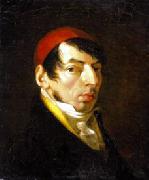 |
Jan Rustem
|
|
(b. 1762 in Istanbul - d. 1835 near Dekštas, Lithuania) was a painter of Armenian, Turkish or Greek ethnicity who lived and worked in the territories of the Polish CLithuanian Commonwealth. Primarily a portrait painter, he was commissioned to execute portraits of notable personalities of his epoch. For many years he was a professor at the University of Vilna, the predecessor of Vilnius University.
He was born in Instanbul, and a young boy was sponsored by Adam Kazimierz Czartoryski who invited him to the Commonwealth around 1774. Czartoryski paid for his studies in Warsaw, where among his tutors were Jean-Pierre Norblin de La Gourdaine and Marcello Bacciarelli. Between 1788 and 1790 he moved to Germany, where he became a freemason. Two years later he returned to the Polish?CLithuanian Commonwealth and lived for some time in Warsaw, later moving to Vilna.
Following the partitions of the Commonwealth, Rustem started working for the Common School of Vilna, which was later remamed the Imperial University of Vilna, as assistant to Franciszek Smuglewicz. After Smuglewicz's death, Rustem took over some of his duties. In 1811 he became a professor of sketching and in 1819 became a professor of painting. Rustem retired in 1826, but continued to give lectures until his death. |
|
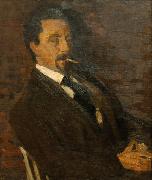 |
Janis Rozentals
|
|
(March 18, 1866, Bebri Farmstead, Saldus parish, Courland Governorate - December 26, 1916) was a Latvian painter.
Rozentels received the basic education at H.Krause's Elementary School in Saldus and Kuldega District School. At the age of fifteen the boy left for Riga and consistently tried to realize his dream about art, later entering St.Petersburg Academy of Art. During study vacations the developing artist visited his native land to relax from the hectic rhythm of the large city, paint motifs from nature and commissioned portraits. For his diploma work he took as models the young educated Latvians and local farmers. A little later the artist decided to settle in Saldus as he wanted to live among his people and create art appropriate to its aspirations and feelings. In spring 1899 Rozentels bought a building plot at the Striķu street and set up a studio, but his intents were not well received in the provincial town and he moved to Riga two years later. Now a memorial museum is arranged in the building designed by the artist. Fateful turn in life of the painter happened in November, 1902, when Janis Rozentels got acquainted with Elli Forsell(1871 - 1943), a Finnish singer, in Riga. On February 20, 1903, they got married. They found home in a flat- studio, in Alberta street, in Riga. they had three children - Laila, Irja and Miķelis. World War I interrupted the family's life in Riga and in 1915 they relocated to Finland. He died suddenly on December 26, 1916 and was buried in Helsinki, though later was reburied in his homeland. Today, the Janis Rozentels Art Highschool in Riga is named after him, and has had his name since 1946. |
|
|
|
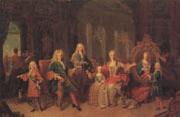 |
Jean Ranc
|
|
French portraits painter, 1674-1735
French painter, active also in Spain. His father was the painter Antoine Ranc (1634-1716), under whom he must have trained. From 1697 he lived in Paris, where he continued his apprenticeship in Hyacinthe Rigaud's studio. After working for some years as Rigaud's assistant, he joined the Academie Royale de Peinture et de Sculpture in Paris in 1703 and reached the rank of academician as a portrait painter in 1707. As Rigaud's protege he worked for the French court, painting portraits of Louis XV (1718; Versailles, Cheteau) and almost certainly other members of the royal family as well as of the aristocracy. He also painted some allegorical and mythological works, such as Vertumnus and Pomona |
|
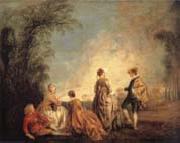 |
Jean Raoux
|
|
French Painter, 1677-1734, French painter. He trained first in Montpellier with Antoine Ranc (1634-1716), in whose studio he completed his early painting Ariadne on Naxos (1701; Montpellier, Mus. Fabre). He subsequently moved to the Paris studio of Bon Boullogne and in 1704 won the Prix de Rome with David Slaying Goliath (untraced). He completed his education at the Acad?mie de France in Rome and also spent time in Florence and Padua. For the Cathedral at Padua he executed an Annunciation and a Visitation (both in situ). In 1707-9 Raoux was in Venice, where he made contact with his future patron Philippe de Vendeme (1665-1727), Grand Prior of the Order of the Knights of Malta. From 1714 he lodged in the Grand Prior's Paris residence, the Temple, a privilege that was renewed in 1719 by Vendeme's successor Jean-Philippe, |
|
 |
Jean Restout
|
|
French Neoclassical Painter, 1692-1768,was a French Neoclassical painter. Jean Restout was born in Rouen, the son of Jean Restout, the first of that name, and of Marie M. Jouvenet, sister and pupil of the then well-known Jean Jouvenet. In 1717, the Royal Academy having elected him a member on his work for the Grand Prix, he remained in Paris, instead of proceeding to Italy, exhibited at all the salons, and filled successively every post of academical distinction. His works, chiefly altar-pieces (Louvre Museum), ceilings and designs for Gobelin tapestries, were engraved by Cochin, Drevet and others; his diploma picture may still be seen at St Cloud. His son, Jean Bernard Restout (1732 - 1797), |
|
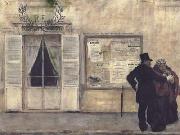 |
Jean-francois raffaelli
|
|
French, 1850-1924
was a French realist painter, sculptor, and printmaker who exhibited with the Impressionists. He was also active as an actor and writer. He was born in Paris, and showed an interest in music and theatre before becoming a painter in 1870. One of his landscape paintings was accepted for exhibition at the Salon in that same year. In October 1871 he began three months of study under Jean-Leon Gerôme at the Ecole des Beaux-Arts in Paris; he had no other formal training. Raffaëlli produced primarily costume pictures until 1876, when he began to depict the people of his time particularly peasants, workers, and rag-pickers seen in the suburbs of Paris in a realistic style. |
|
 |
Jerg Ratgeb
|
|
Jerg Ratgeb (also Jörg) (born circa 1480 in Schwäbisch Gmend; died 1526 in Pforzheim) was a German painter and contemporary of Derer.
Around the turn of the 15th to 16th century, Ratgeb appears to have spent time in Italy, where he came in contact with Italian Renaissance art and with the recently developed use of perspective in painting. After returning to Germany, he settled in Heilbronn. In 1510, he painted the altar of Saint Barbara in the church of nearby Schwaigern.
From 1514 to 1517 he was in Frankfurt am Main, where he painted the walls of the refectory and cloister of the Karmeliterkloster (Carmelite Monastery). The paintings, of which only fragments survive, are the largest wall paintings known to the north of the Alps from that period. His most famous work is the Herrenberg Altarpiece, completed in 1521. It was originally painted for the Stiftskirche (abbey church) of Herrenberg. Today, it is on display in the Staatgalerie at Stuttgart. Ratgeb had developed a distinctive personal expressive style, visibly influenced by artists such as Albrecht Derer, Matthias Grenewald and Hieronymus Bosch.
Fresco in the Karmeliterkloster, Frankfurt am Main.
Copy of the altarpiece in the abbey church at Herrenberg - here depicted when closed
Because of his marriage with a serf of the Duke of Werttemberg he lost most of his rights as a citizen of Heilbronn. He moved to Stuttgart, where he became a member of the city council. In that position, he negotiated with the rebelling farmers during the German Peasants' War in 1525. He became part of the military contingent requested by the rebels and was elected councillor and chancellor by the peasants. After the suppression of the rebellion, he was arrested, accused of high treason ("because of the Peasant War and on behalf of Duke Ulrich") and finally executed in Pforzheim in 1526, by being torn apart by four horses. |
|
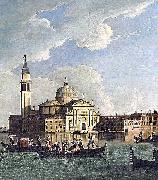 |
Johan Richter
|
|
(1665 - 1745) was a Baroque painter, born in Sweden, but painting mainly landscapes or veduta of Venice.
Richter was born in Stockholm and died in Venice. He was known to be active in Venice by 1717. He was influenced by Luca Carlevarijs.
|
|
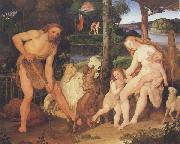 |
Johann anton ramboux
|
|
German, 1790 - 1866
German painter, draughtsman and museum curator. He was taught drawing by Jean-Henri Gilson (1741-1809), before he went to Paris for further training in the studio of Jacques-Louis David. In 1812 he returned to Trier, painting portraits until 1815, when he spent a year at the Akademie der Bildenden K?nste in Munich. In 1816 he went to Rome, where he was part of the Nazarene circle without becoming a member of the Lukasbr?der. Close association with these artists, notably Peter Cornelius, Carl Philipp Fohr and Julius Schnorr von Carolsfeld, had a more lasting influence on Ramboux's artistic development than his earlier studies with David |
|
|
|
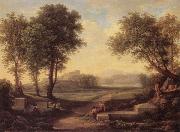 |
Johann Christian Reinhart
|
|
German , 1761-1847
He revealed an interest in art while still at school and, though he began to study theology in Leipzig in 1778, he soon transferred to the private art academy of Adam Friedrich Oeser (1717-99). Here he made copies of the work of his teacher and drew after plaster casts of antique statues. The Liber Veritatis, a collection of 200 drawings by Claude Lorrain, was also used as a model and had an important influence on him. In 1783 he went to Dresden where he was especially attracted to the Dutch landscape paintings in the Gem?ldegalerie. In 1785 Reinhart returned to Leipzig where he made the acquaintance of the German poet Friedrich Schiller, with whom he had a lifelong friendship, and to whom he later dedicated an etching of a heroic landscape (1800). From 1786 to 1789, while resident at the court of the Duke of Sachsen-Meiningen, he explored the Thuringian countryside on foot, making sketches as he went. |
|
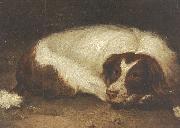 |
Johann Christoph Rincklake
|
|
Johann Christoph Rincklake (1764-1813).
Date of birth and death 19 October 1764(1764-10-19) and 19 June 1813(1813-06-19) .
Location of birth and death, Harsewinkel and Munster. |
|
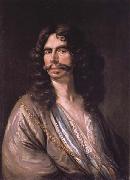 |
Johann Heinrich Roos
|
|
German Baroque Era Painter, 1631-1685
was a German Baroque era painter and etcher. His works are presented in various art museums worldwide. |
|
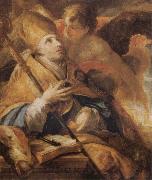 |
Johann Michael Rottmayr
|
|
Austrian,1654-1730
Austrian painter and draughtsman. He is most notable for large-scale religious and secular decorative schemes, and his career heralded the important 18th-century German contribution to late Baroque and Rococo fresco painting. He was probably taught by his mother, who was a painter of wooden sculpture. Between 1675 and 1687-8 he was in Venice as a pupil and assistant of the Munich artist Johann Carl Loth, whose studio attracted many painters from Austria and southern Germany. It is possible that Rottmayr also visited other Italian cities, in particular Bologna and Rome. He returned to Salzburg in the late 1680s a mature painter and immediately received commissions for panels and frescoes. In 1689 he painted mythological scenes for the Karabinierisaal at the Residenz in Salzburg (in situ); in composition and style these are close to high Baroque models, particularly the work of Pietro da Cortona and Peter Paul Rubens. Such models, as well as the example of Loth, and Venetian painting, had an important influence on Rottmayr's panel paintings of this period, for example the Sacrifice of Iphigenia (c. 1691; Vienna, Belvedere) or St Agnes (1693-5) and St Sebastian (1694; both Passau, Cathedral). In these, the solidity of the figures is emphasized through the use of intense colours. For Rottmayr, however, the rational development of the figures and the composition was less important than the overall effect achieved by the use of colour. Incorrect details of anatomy and perspective found compensation in greater expressiveness, mainly conveyed by gesture and pose. Rottmayr's images are filled with plastic elements, creating a staccato effect. Several very important early commissions paved the way for Rottmayr's move to Vienna in the late 1690s. |
|
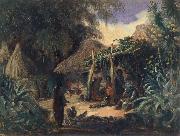 |
Johann Moritz Rugendas
|
|
Augsburg 1802-1858 Weilheim an der Teck,was a German painter, famous for his works depicting landscapes and ethnographic subjects in several countries in the Americas, in the first half of the 19th century. Rugendas was born to the seventh generation of a family of noted painters and engravers of Augsburg (he was a grandson of Georg Philipp Rugendas, 1666-1742, a celebrated painter of battles), and studied drawing and engraving with his father, Johann Lorenz Rugendas II (1775-1826). From 1815 to 1817 he studied with Albrecht Adam (1786-1862), and later in the Academy de Arts of Munich, with Lorenzo Quaglio II (1793-1869). Inspired by the artistic work of Thomas Ender (1793-1875) and the travel accounts in the tropics by Austrian naturalists Johann Baptist von Spix (1781-1826) and Carl von Martius (1794-1868), Rugendas arrived in Brazil in 1821, where he was soon hired as an illustrator for Baron von Langsdorff's scientific expedition to Minas Gerais and Sao Paulo. Langsdorff was the consul-general of the Russian Empire in Brazil and had a farm in the northern region of Rio de Janeiro, where Rugendas went to live with other members of the expedition. In this capacity, Rugendas visited the Serra da Mantiqueira and the historical towns of Barbacena, Sao Joao del Rei, Mariana, Ouro Preto, Caete, Sabara and Santa Luzia. |
|
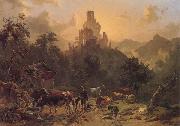 |
Johann Nepomuk Rauch
|
|
(1804 Vienna - 1847 Rome) was a very significant Austrian Biedermeier painter of the 1st half of the 19th century. |
|
 |
Johann Rudolf Huber
|
|
Johann Rudolf Huber (April 21, 1668; February 24, 1748) was an eminent Swiss portrait artist. Among his famous subjects were Charles III William, Margrave of Baden-Durlach, Joseph I, Holy Roman Emperor and Albrecht von Haller .
|
|
|
|
|
|
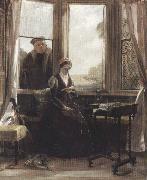 |
John callcott horsley,R.A.
|
|
1817-1903
English painter. A nephew of the landscape painter Augustus Wall Callcott, and later Isambard Kingdom Brunel's brother-in-law, he was born into the artistic establishment. He was educated at Henry Sass's Academy and at the Royal Academy. Although he executed two frescoes for the Houses of Parliament (The Spirit of Religion, 1847; London, House of Lords; Satan Wounded by Ithuriel's Lance, 1848; London, Pal. Westminster), his career began with portraiture. Success later came with literary subjects, |
|
|
|
|
|
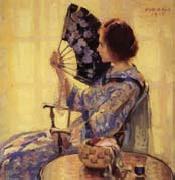 |
John Hubbard Rich
|
|
American,a versatile artist painting portraits, still lifes, figures and florals1878-1955
|
|
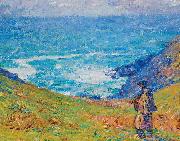 |
John Peter Russell
|
|
(16 June 1858 -22 April 1930) was an Australian impressionist painter.
John Peter Russell was born at the Sydney suburb of Darlinghurst, the eldest of four children of John Russell, a Scottish engineer, his wife Charlotte Elizabeth, nee Nicholl, from London. J. P. Russell was a nephew of Sir Peter Nicol Russell. After his father's death J. P. Russell enrolled at the Slade School of Fine Art, University College, London, on 5 January 1881 and studied under Alphonse Legros for three years.Russell then went to Paris to study painting under Fernand Cormon. (His fellow students there included Henri de Toulouse-Lautrec and Émile Bernard.) Russell was a man of means and having married a beautiful Italian, Mariana Antoinetta Matiocco, he settled at Belle Île off the coast of Brittany, where he established an artists' colony. He would have 11 children with Matiocco, of whom six survived.
John Peter Russell: Vincent van Gogh, 1886, Van Gogh Museum, AmsterdamRussell had met Vincent van Gogh in Paris and formed a friendship with him. Van Gogh spoke highly of Russell's work, and after his first summer in Arles in 1888 he sent twelve drawings of his paintings to Russell, to inform him about the progress of his work. Claude Monet often worked with Russell at Belle Île and influenced his style, though it has been said that Monet preferred some of Russell's Belle Île seascapes to his own. |
|
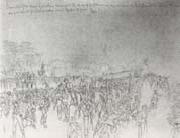 |
John R.Chapin
|
|
1823 - 1904,was a 19th-century American artist and illustrator, who worked for Harper's Magazine. He was especially noted for a series of illustrations entitled Artist life in the highlands of New Jersey published in April 1860 which gave a realistic depiction of the daily life of miners. |
|
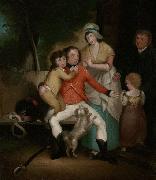 |
John Ritto Penniman
|
|
John Ritto Penniman (1782-1841) was a painter in Boston, Massachusetts, USA. He created portraits, landscapes, and allegorical paintings, as well as designs for engravings, such as the official seal of the city of Boston in 1822. He also worked as an assistant to Gilbert Stuart. Penniman died in 1841 in Baltimore. |
|
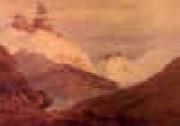 |
John Robert Cozens
|
|
British
1752-1797
). Painter, draughtsman and printmaker, son of (1) Alexander Cozens.
He was taught by his father, and an album by John Robert (Aberystwyth, N. Lib. Wales) indicates that he also learnt to sketch landscape directly from nature. The album contains drawings that record sketching tours to Nacton, near Ipswich, Suffolk (Aug 1768); day trips to the outskirts of London: Greenwich and Blackheath (1768, 1771), Epsom (1768) and Hampstead (1770-71); and a trip to Matlock, Derbys (June 1772). The earliest of these sketches are careful pencil drawings, some later reworked in pen, ink and wash, and there is at least one attempt at added colour. Later drawings are freer, either noting an idea for a composition or recording light and shade with rapid washes of ink over pencil. His father worked mainly in monochrome brown or grey washes, and John Robert earliest exhibits (he exhibited at the Society of Artists every year from 1767 to 1771) were also in this medium. |
|
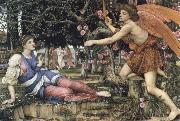 |
John Roddam Spencer Stanhope
|
|
English Pre-Raphaelite Painter, 1829-1908,English painter. The second son of Yorkshire landed gentry, he was educated at Rugby and Christ Church, Oxford. In 1850 he studied in London with G. F. Watts, through whom he entered the artistic circle at Little Holland House, where he met D. G. Rossetti and Edward Burne-Jones. In 1857 Rossetti invited him to paint at the Oxford Union (Sir Gawaine and the Damsels at the Fountain), and in 1858 Stanhope occupied a studio next to Rossetti's at Chatham Place, Blackfriars (London), where he painted Thoughts of the Past (London, Tate); a modern-life subject indebted to Rossetti, it shows a prostitute recalling her former life. Stanhope's close friendship with Burne-Jones proved a more decisive influence on his work that, in the 1860s, consisted of dreamlike poetic and mythological subjects often set in quaint, enclosed spaces, as in I Have Trod the Winepress Alone |
|
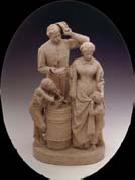 |
John Rogers
|
|
American Sculptor, 1829-1904, He was an American sculptor who produced very popular, relatively inexpensive figurines in the latter 19th century. He became famous for his small genre sculptures, popularly termed "Rogers Groups", which were mass produced in cast plaster. A total of 80,000 copies of almost 80 Rogers Groups were sold across the United States and abroad. At the height of their popularity, Rogers' figurines graced the parlors of homes in the United States and were found as far away as Chile and Australia. The English novelist Charles Reade furnished his home with all the Rogers figurines available to him, and in the Dakota Territory, Lt. Col. George Custer and his wife had one. |
|
 |
John Rogers Herbert
|
|
English historical painter and portraitist .
British, 1810-1890.
was an English painter who is most notable as a precursor of Pre-Raphaelitism. Herbert was born in Maldon, Essex. In 1825, he moved to London to study at the Royal Academy. His early works were influenced by the troubadour style of Richard Parkes Bonington. Subjects showed the influence of Byron and exotic episodes of Venetian history. Haydee (1834) depicted the heroine of Byron's poem Don Juan. Herbert's first major success was The Appointed Hour (1835), depicting a melodramatic scene in which a Venetian man lies murdered at the place appointed for a tryst with his lover. The work became a popular engraving. Herbert followed it with other dramatic subjects such as A Prisoner of Condottieri Freed (1836) and Desdemona asks for Cassio (1838). After he was chosen to paint a portrait of Princess Victoria, before she became queen, he became a favourite portrait painter of the aristocracy. Around this time, he came under the influence of the architect William Payne, a convert to Catholicism. In 1840, Herbert also converted to the Catholic Church. He then painted mainly religious subjects in a style influenced by the artists of the Nazarene movement. Herbert was elected to membership of the Royal Academy in 1846. Herbert's paintings The First Introduction of Christianity into Great Britain (1842) and Our Saviour Subject to his Parents in Nazareth (1847) were the inspiration for the two most important early works of William Holman Hunt and John Everett Millais, founders of Pre-Raphaelitism. The two paintings, Hunt's A Converted British Family Sheltering a Christian Missionary and Millais' Christ in the House of His Parents were exhibited at the RA in 1850 to great controversy. |
|
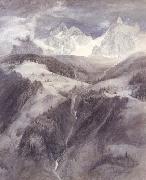 |
John Ruskin
|
|
English Romantic Writer and Painter, 1819-1900
English art critic. Born into a wealthy family, Ruskin was largely educated at home. He was a gifted painter, but the best of his talent went into his writing. His multivolume Modern Painters (1843 C 60), planned as a defense of painter J.M.W. Turner, expanded to become a general survey of art. In Turner he saw "truth to nature" in landscape painting, and he went on to find the same truthfulness in Gothic architecture. His other writings include The Seven Lamps of Architecture (1849) and The Stones of Venice (1851 C 53). He was also a defender of the Pre-Raphaelites. In 1869 he was elected Oxford's first Slade professor of fine art; he resigned in 1879 after James McNeill Whistler won a libel suit against him. |
|
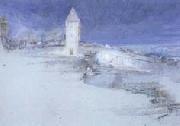 |
John Ruskin,HRWS
|
|
1819-1900
English academic and critic, who had an enormous influence not only on architectural style but on the ways in which standards of aesthetics were judged. He used an Evangelical and polemical tone in his writings that not only reached a mass audience but received the approval of the Ecclesiologists. Initially encouraged by J. C. Loudon, he contributed to some of Loudon's publications, but his key works date from the late 1840s and 1850s. The Gothic Revival was well established when Ruskin published The Seven Lamps of Architecture (1849), which was an immediate success, encapsulating the mood of the period rather than creating new ideas. He argued that architecture should be true, with no hidden structure, no veneers or finishes, and no carvings made by machines, and that Beauty in architecture was only possible if inspired by nature. As exemplars worthy of imitation (he argued that the styles known to Man were quite sufficient, and that no new style was necessary) he selected Pisan Romanesque, early Gothic of Western Italy, Venetian Gothic, and English early Second Pointed as his paradigms. In the choice of the last, the style of the late C13 and early C14, he was echoing A. W. N. Pugin's preferences as well as that of most ecclesiologically minded Gothic Revivalists such as G. G. Scott. The Stones of Venice (1851C3) helped to promote that phase of the Gothic Revival in which Continental (especially Venetian) Gothic predominated. Deane and Woodward's University Museum, Oxford (1854C60), is an example of Venetian or Ruskinian Gothic. In particular, structural polychromy, featuring colour in the material used, rather than applied, was popularized by Ruskin's writings. |
|
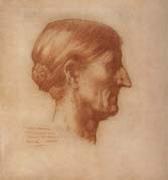 |
John Russell
|
|
English Painter, 1745-1806,English pastellist, painter, writer and astronomer. His father, also called John Russell (1711-1804), was a bookseller, printseller and amateur artist. Russell was educated at Guildford grammar school and won premiums from the Society of Artists for drawings in 1759 and 1760. He was apprenticed to Francis Cotes and set up his own practice in 1767. In 1770 he entered the Royal Academy Schools, London, winning the silver medal for figure drawing. He exhibited at the Society of Artists in 1768 and annually at the Royal Academy from 1769 to 1806. He was elected ARA in 1772 and RA in 1788, when he became Crayon Painter to King George III and to George, Prince of Wales. He painted some rather stilted portraits in oil |
|
 |
John Samuel Raven
|
|
(1829-1877) was an English landscape painter.
Raven was born in Suffolk in 21 Aug. 1829. He was the son of the Rev. Thomas Raven, a clergyman of the Church of England, who had considerable talent as an amateur artist, as may be seen from six water-colour drawings by him in the South Kensington Museum.
John Raven was, however, almost entirely self-taught, initially by studying the works of John Crome and John Constable. He exhibited at the Academy as early as 1845, and his works also appeared at the British Institution. This part of his career was focused on views of the area where he lived, near St. Leonards[disambiguation needed]. He at first fell under the influence of the Norwich school, but his maturer works, which show much poetic feeling, bear traces of pre-Raphaelitism. It was his custom to prepare elaborate cartoons for his pictures. He was drowned while bathing at Harlech in 13 June 1877.
He married Margaret Sinclair Dunbar in 1869. |
|
|
|
|
|
|
|
|
|
 |
Jorg Ratgeb
|
|
German Northern Renaissance Painter, ca.1480-1526 |
|
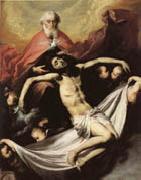 |
Jose de Ribera
|
|
Spanish Painter and Print engraver , 1591-1652
Information concerning the life and personality of Jusepe de Ribera is sparse. He was born the son of a shoemaker in Jetiva, Valencia Province. He appears to have gone to the city of Valencia while still a boy, but nothing is known of his possible artistic training there. As an adolescent, he traveled to Italy and spent time in Lombardy. Next he was in Parma, from which, it is said, he was driven by the contentious jealousy of local artists. He located himself in Rome until an accumulation of debts forced him to flee. Finally he settled in Naples, where in 1616 he married Caterina Azzolino, the daughter of a painter, by whom he had seven children between the years 1627 and 1636. The Academy of St. Luke in Rome elected Ribera to membership in 1625, and 6 years later the Pope conferred upon him the Order of Christ. It is understandably speculated that Ribera revisited Rome for these events. Being sought after in Naples by the Church and the various Spanish viceroys who ruled there in the name of the Spanish monarchy, he dismissed the idea of returning to his homeland. He was quoted as saying that he was honored and well paid in Naples and that Spain was a cruel stepmother to its own children and a compassionate mother to foreigners. Nevertheless, he generally added his nationality when he signed his works. This practice inspired the Italians to nickname him "the Little Spaniard" (Lo Spagnoletto). The last decade of Ribera's life was one of personal struggle. He suffered from failing health, the taunts of other artists that his fame was "extinct," and difficulty in collecting payments due him. Nevertheless, he kept it from being a tragic defeat by continuing to paint until the very year of his death in Naples. Actually, he was the victim of the local politics and finances. Naples was in the throes of a severe economic depression for which the foreign rulers, the patrons of Ribera, were naturally blamed, and the desperate citizenry was rioting in the streets. It is significant that Ribera continued to receive commissions in such a time, even if there was a dearth of payments. Ribera was inventive in subject matter, ranging through visionary spectacles, biblical themes, genre, portraits, mythological subjects, and portraits of ascetics and penitents. |
|
|
|
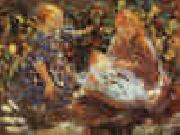 |
Joseph Raphael
|
|
1869-1950
Joseph Morris Raphael holds a high place in the California, American and French Schools of Impressionism. Born in the town of Jackson, California on June 2, 1869, Raphael became one of the most famous students of his esteemed teacher Arthur F. Mathews at the California School of Design. Later Raphael would continue his art studies in Paris at the Ecole des Beaux-Arts, and at the Academie Julian under Jean-Paul Laurens. Early in his career he made the decision to settle in Europe in Uccle, Belgium where he and his wife established a home and raised their family.
For most of his career he remained a devoted follower of pure French Impressionism. He painted the countryside near his home in Uccle, Belgium and also ventured to Holland and France to paint. Just as Raphael's international reputation grew, his family grew as well to include four daughters and one son. His family frequently appeared in his figurative works, he created wonderful closeup studies of his children and frequently captured them in leisurely picnic settings. Other paintings featured local landscapes, and sometimes his charming cottage home with its vegetable and flower gardens which were perhaps a source for his still lifes of fruits, vegetables and flowers. He lived and worked in Europe for thirty-seven years always maintaining close ties with the San Francisco art community and his loyal art dealer and collector Albert M. Bender. In 1939 with the ominous clouds of World War Two approaching, he wisely chose to return to San Francisco where he lived and maintained a studio on Sutter Street until his death on December 11th, 1950. |
|
|
|
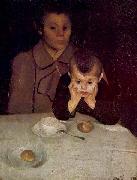 |
Josip Racic
|
|
(1885 - 1908) was a Croatian painter in the early 20th century. Although he died very young (he was only 23), and his work was mostly created when a student, he is one of the best known of the modern Croatian painters. Today, Račić is regarded as one of the most important representatives of Croatian modern painting.
He studied lithography in Zagreb, and 1904 he went to Vienna and Munich, where he studied for a year at the school of the Slovene painter and teacher Anton Ažbe, followed by 3 years at the prestigious Academy of Arts. There, Racic, along with Oskar Herman, Vladimir Becić and Miroslav Kraljević formed the group known as the Croatian School. In 1908, he went to Paris where he painted a series of watercolors and oils depicting Parisian bridges, avenues and parks. He died of a gunshot wound in a Paris hotel room in June 1908, having committed suicide.
Josip Račić is one of the founders of modern Croatian art, the first to bring the concept of self-awareness and artistic integrity to his life and works, "pure painting", as he called it. A particular feature of his paintings is the strong dark realms of human spirituality. A retrospective of his work was held in the Modern Gallery in Zagreb and Dubrovnik in 2008-2009, to mark the 100th anniversary of the artist's death.
|
|
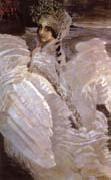 |
Jozsef Rippl-Ronai
|
|
Hungarian Painter, 1861-1927
After his studies at the highschool in Kaposvar he went to study to Budapest, where he got a degree in pharmacy. In 1884 he travels to Munich to study painting at the Academy. 2 years later he gets a grant and that makes him able to move to Paris and study by Munkacsy. In 1888 he meets with the members of Les Nabis and under their influence he paints his first important work The Inn at Pont-Aven, a very deep paining with dark atmosphere. His first big success was the paining My Grandmother (1894).
Later he travels back to Hungary, first the critics does not accept him very warmly, but finally he celebrates a success with the exhibition Rippl-Ronai Impressions 1890-1900. He believes that for an artist there is important not only his work, but also how he lives and what he wears. That is why he becomes also a designer (Andrassy dining room and the window-pane in the Ernst Museum). His exhibitions in Frankfurt, Munich and Vienna have got a great success in 1911-1913. He paints his last big work in 1919 (portrait of his friend Zorka) and in 1927 dies in his villa Roma in Kaposvar. |
|
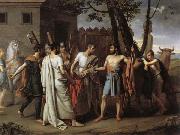 |
Juan Antonio Ribera Y Fernandez
|
|
1779-1860
was a Spanish painter, born at Madrid. He first studied under Francisco Bayeu and enrolled into the Royal Academy of San Fernando, but afterwards went to Paris and become the pupil of Jacques-Louis David. There he painted his Cincinnatus which is now in the Prado Museum. In course of time he went to Rome, and in 1811 was appointed painter to Carlos IV and member of the Academy of St. Luke; and in 1820, honorary member of the Academy of San Fernando. In 1838 he was made professor, and two years afterwards Director of the Prado. He died at Madrid. |
|
|
|
 |
Juan Ribalta
|
|
b. 1597, Madrid, d. 1628, Valencia,was a Spanish painter of the Baroque period. Born and died in Valencia. His father, Francisco Ribalta, was a famous painter, active in the style of Caravaggio. Juan's works and style are similar to that of his father.
|
|
|

